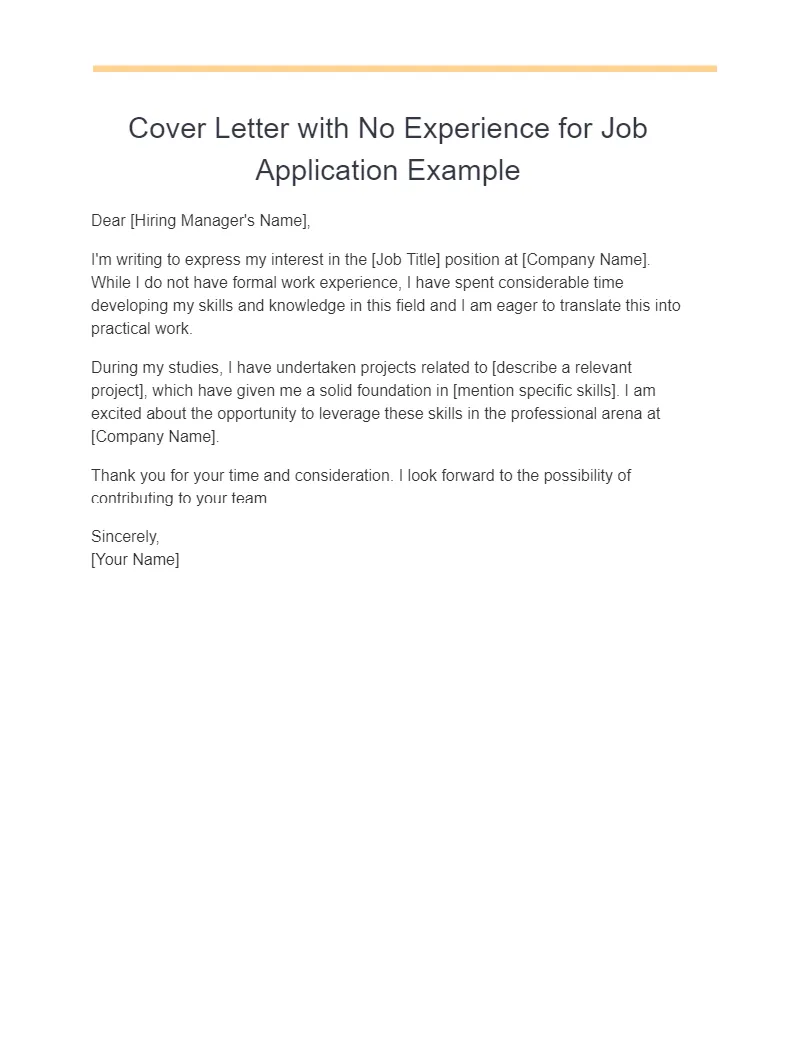What is a Cover Letter and Why Is It Important?
A cover letter is a crucial document accompanying your resume when applying for a job. It serves as your first introduction to a potential employer, offering a chance to showcase your personality, express your interest in the role, and highlight the skills and experiences that make you a suitable candidate. While a resume provides a factual overview of your qualifications, the cover letter allows you to tell your story, explaining why you are the best fit for the position and how your aspirations align with the company’s goals. Even if you lack direct work experience, a well-crafted cover letter can significantly improve your chances of securing an interview. It provides a platform to demonstrate your enthusiasm, express your understanding of the job requirements, and showcase your potential, making you stand out among other applicants, especially those with extensive experience. This is your opportunity to present yourself as a person, not just a list of accomplishments.
Cover Letter Structure
A well-structured cover letter is essential for making a positive impression. A standard cover letter typically follows a clear format that includes a header, a personalized greeting, an introduction, body paragraphs, a conclusion, and a professional closing. The header should contain your contact information, the date, and the employer’s details. The greeting should be addressed to a specific person whenever possible; otherwise, use a professional salutation. The introduction should clearly state the position you’re applying for and how you learned about it. The body paragraphs should elaborate on your qualifications, highlighting your skills and experiences that align with the job requirements. The conclusion should summarize your interest and reiterate your call to action, expressing your eagerness for an interview. By following a structured format, you ensure your letter is easy to read, professional, and persuasive. Consider using clear, concise language and formatting to make your letter visually appealing and easy to scan. (cover-letter-structure.webp)
Header of a Cover Letter

The header of your cover letter is the first thing a hiring manager sees, so it must be accurate and professional. Begin by including your full name, phone number, email address, and, optionally, your LinkedIn profile URL. This information allows the employer to easily contact you. Following this, include the date you are sending the cover letter. Then, provide the employer’s information, including their name, title, company name, and address. Ensure all details are accurate. The header sets the tone of professionalism and should be formatted consistently with your resume to maintain a unified brand. Using a clean, readable font and layout is essential to avoid any confusion. The header ensures the employer knows how to contact you and provides necessary context for your application. Double-check all the details for any errors before sending your application.
Personalized Greeting
A personalized greeting, such as “Dear Mr. Smith,” is crucial for making a positive first impression. Research the hiring manager’s name and title to address the letter specifically to them. This shows that you’ve taken the time to learn about the company and its staff, demonstrating your genuine interest in the position. If you cannot find the hiring manager’s name, use a professional alternative, like “Dear Hiring Manager” or “Dear [Department Name] Team.” Avoid generic greetings like “To Whom It May Concern,” as they can appear impersonal and demonstrate a lack of effort. Ensure the spelling and title are correct to demonstrate attention to detail and professionalism. A personalized greeting immediately establishes a connection and makes your application stand out from the crowd. (cover-letter-examples-no-experience-intro.webp)
Body Paragraphs for No Experience
When writing body paragraphs without prior experience, focus on showcasing transferable skills, highlighting relevant projects, and demonstrating your enthusiasm for the role and company. Begin by explaining why you are interested in the specific position and the company, and how your skills align with the job requirements. Elaborate on experiences from education, volunteer work, or personal projects that demonstrate relevant skills, such as teamwork, communication, problem-solving, or leadership. Use specific examples to illustrate your abilities and achievements, even if they are not directly work-related. For each skill or experience, quantify your results whenever possible to provide concrete evidence of your impact. Always tailor your letter to match the job description, highlighting the skills and experiences that the employer is looking for. Use action verbs to describe your accomplishments and provide concise, engaging information that keeps the reader interested.
Highlight Transferable Skills
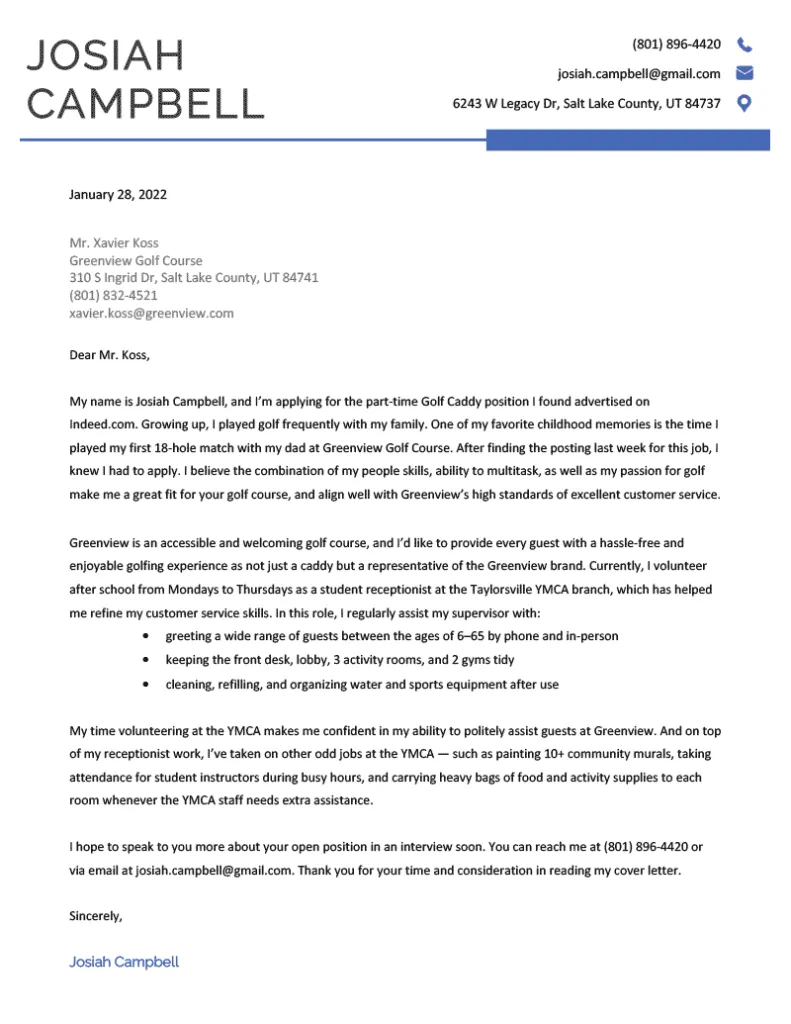
Transferable skills are abilities that can be applied across different jobs and industries. Identifying and highlighting these skills is particularly important if you have no direct work experience. Consider skills such as communication, teamwork, problem-solving, time management, leadership, and adaptability. Draw examples from your educational background, volunteer work, extracurricular activities, or personal projects to showcase these skills. If you managed a group project in school, describe how you delegated tasks, resolved conflicts, and ensured deadlines were met. If you volunteered, explain how you communicated with clients or colleagues and the impact of your contributions. Quantify your achievements whenever possible; for example, if you improved a process, state the percentage of improvement or the number of people affected. Tailor the skills you emphasize to match the job description and show the employer how your abilities make you a good fit for the role. (transferable-skills.webp)
Showcase Your Education and Projects
Your educational background and any projects you have undertaken can demonstrate valuable skills and knowledge even without prior work experience. Describe relevant coursework, research projects, or academic achievements. Highlight any projects that align with the job requirements, emphasizing your role, the skills you used, and the outcomes you achieved. For example, if you designed a website for a school project, explain the technologies you used, the challenges you overcame, and the results you achieved. If you participated in a group project, describe your contributions to the team and the skills you developed, such as communication, problem-solving, or project management. Quantify your achievements whenever possible; e.g., “Improved website traffic by 15%” or “Managed a team of five students to complete the project ahead of schedule.” Your academic experiences show your ability to learn, adapt, and apply your knowledge, making them a significant asset in your cover letter. (education-projects.webp)
Tailor Your Letter to the Job Description
Customizing your cover letter to match each job description is essential for demonstrating your genuine interest and suitability for the role. Carefully read the job description, identifying the key skills, qualifications, and experiences the employer is seeking. Then, align your cover letter content to highlight the skills and experiences you possess that directly address these requirements. Use the same keywords and phrases from the job description to showcase your understanding of the role and your ability to meet the employer’s needs. For example, if the job description requires project management skills, highlight any project management experience you have, even if it is from academic or volunteer settings. Explain how your skills and experiences make you a good fit for the position and the company. By tailoring your cover letter, you show that you have taken the time to understand the specific needs of the role and how you can contribute to the team. (quantify-achievements.webp)
Quantify Your Achievements (Even Without Experience)
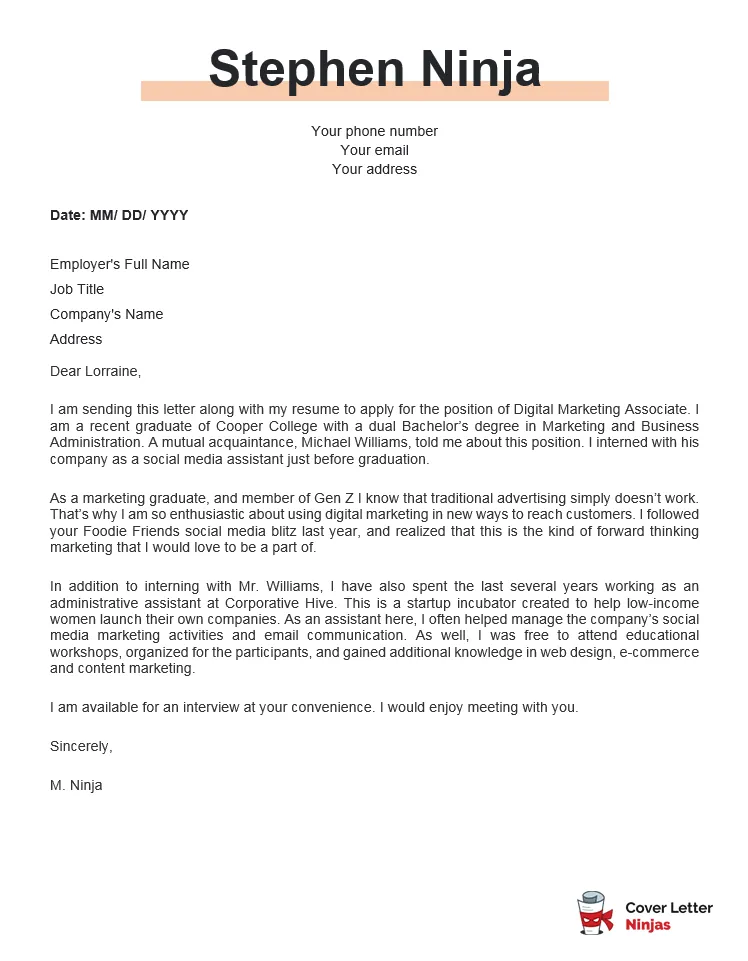
Quantifying your accomplishments is a powerful way to make your cover letter more compelling, even if you lack work experience. Whenever possible, use numbers, percentages, or specific data to demonstrate the impact of your skills and contributions. For instance, instead of saying you “improved customer service,” state that you “reduced customer complaint resolution time by 20%.” When discussing projects or assignments, include measurable results, such as the number of people involved, the amount of money saved, or the percentage of improvement achieved. Use action verbs to describe your accomplishments, and then provide the specific details that support your claims. Even if you do not have a traditional work background, you can still quantify achievements from your education, volunteer work, or personal projects. Quantifying your achievements proves that you can deliver results, making you a more attractive candidate. For example, “Increased social media engagement by 30%” or “Managed a budget of $5,000 for the event.”
Concluding Your Cover Letter
The conclusion of your cover letter is an opportunity to reiterate your interest in the position and make a strong call to action. Summarize why you are a good fit for the role, highlighting your key skills and experiences and how they align with the company’s needs. Reiterate your enthusiasm for the opportunity and express your desire to learn more about the position. Clearly state your expectation for the next step, such as requesting an interview or providing additional information. Thank the hiring manager for their time and consideration. You may also include a brief statement about where you learned about the job, such as LinkedIn, the company website, or a job board. The conclusion should be concise, professional, and leave a positive lasting impression. End the letter with a professional closing such as “Sincerely” or “Best regards.” (enthusiasm-call-to-action.webp)
Expressing Enthusiasm and Call to Action
Expressing enthusiasm is vital for capturing the hiring manager’s attention and demonstrating your genuine interest in the role and company. Use positive and energetic language throughout your cover letter to convey your excitement about the opportunity. Mention what specifically interests you about the company’s mission, values, or recent achievements. In the conclusion, clearly state your desire for an interview and make a call to action, such as stating your availability for an interview. Let the hiring manager know how eager you are to discuss your qualifications further and how you can contribute to the company’s success. End your letter by thanking the hiring manager for their time and consideration. A well-crafted call to action and enthusiastic tone can significantly improve your chances of securing an interview and landing the job. A positive and proactive approach throughout your cover letter will make you memorable.
Cover Letter Examples [5]
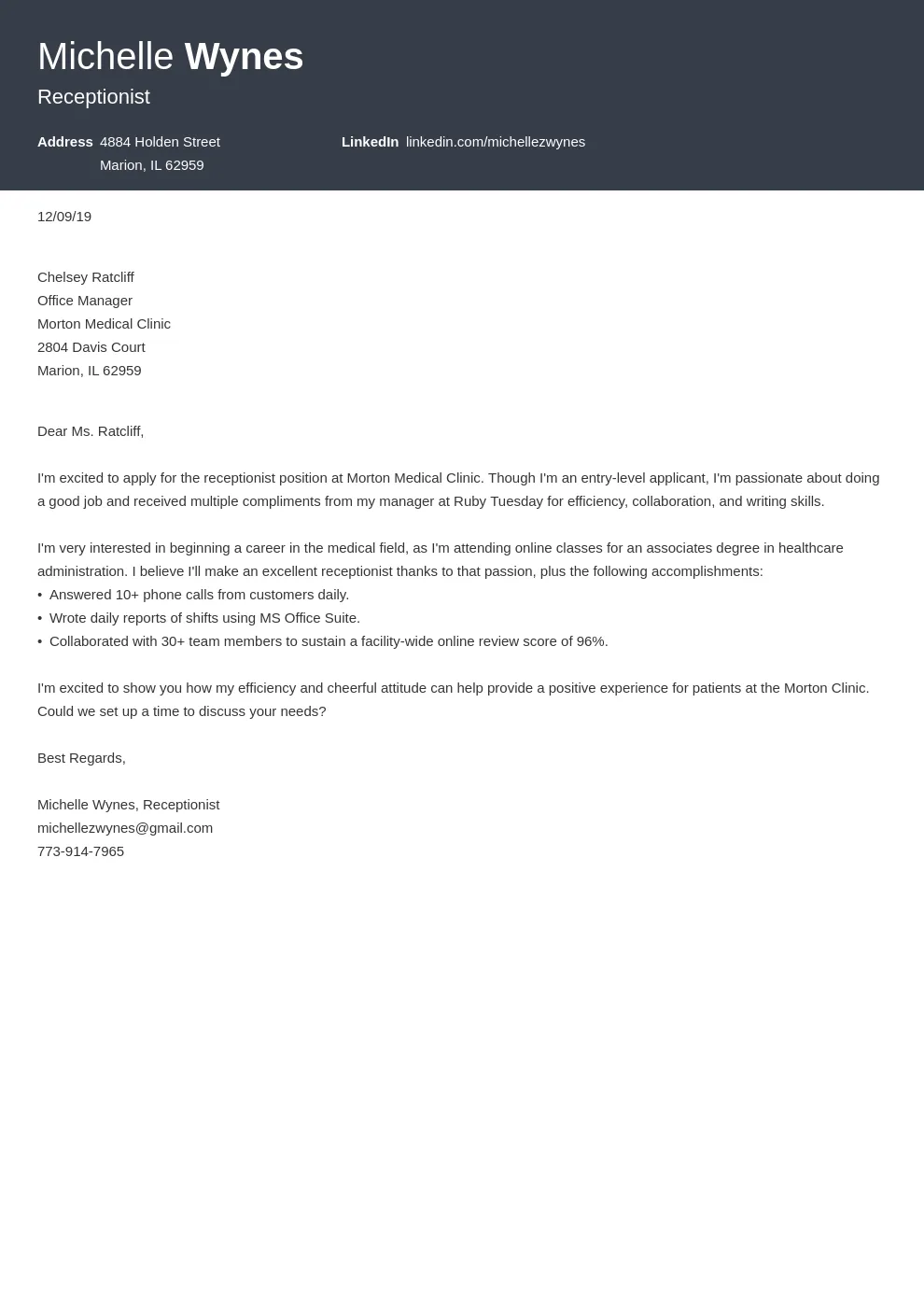
Below are five cover letter examples tailored for individuals with no prior work experience, demonstrating how to highlight various aspects of their qualifications and experiences. Each example focuses on a specific approach to showcase transferable skills, educational achievements, or personal projects, allowing you to adapt the template to your unique background and the job’s requirements. Remember to customize these examples to match your specific situation and the job description.
Example 1 Highlighting Skills and Enthusiasm
Dear [Hiring Manager Name],
I am writing to express my strong interest in the [Job Title] position at [Company Name], as advertised on [Platform]. As a recent graduate with a [Degree] in [Major], I am eager to apply my skills and contribute to your team’s success. While I may not have direct work experience, my academic projects and extracurricular activities have equipped me with several transferable skills. For example, in my role as [Role] at [Organization], I improved [Skill] by [Percentage]. I am passionate about [Company’s mission] and believe my strong communication, problem-solving, and teamwork skills make me an excellent fit for this role.
Thank you for your consideration. I look forward to the opportunity to discuss my qualifications further.
Sincerely, [Your Name]
Example 2 Focusing on Education and Projects
Dear [Hiring Manager Name],
I am writing to express my interest in the [Job Title] position at [Company Name]. As a recent graduate in [Major] from [University Name], I am excited about the chance to leverage my academic achievements and project experience. During my studies, I successfully completed a project on [Project Title], where I developed my skills in [Skills used] and achieved [Quantifiable Result]. I am also proficient in [List of Software] and possess a strong understanding of [Industry Knowledge]. I am eager to apply my skills and experience to contribute to [Company Name]’s innovative work and am keen to learn from experienced professionals in the field.
Thank you for your time and consideration. I welcome the opportunity to discuss how my skills align with the requirements of this position.
Sincerely, [Your Name]
Example 3 Addressing a Career Change
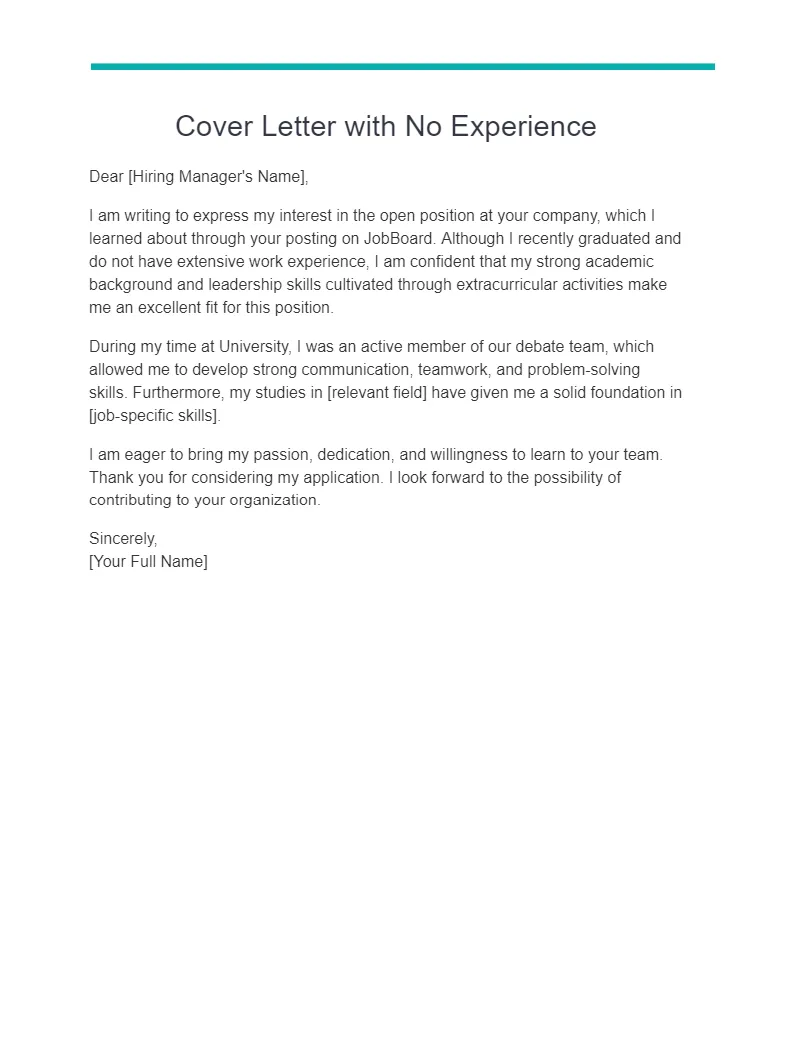
Dear [Hiring Manager Name],
I am writing to express my interest in the [Job Title] position at [Company Name]. While my background is in [Previous field], I am eager to transition my career to [New field]. My experience in [Previous role] has equipped me with essential skills such as [List of Skills], which are directly transferable to the responsibilities outlined in your job description. I have been actively working on expanding my knowledge in [New Field] through [List of Courses/Certifications], which has allowed me to gain a strong foundation in [Key aspects of New Field]. I am highly motivated to contribute my expertise and drive to the [Company Name] team and am confident I can quickly adapt and make a meaningful contribution.
Thank you for your time and consideration. I welcome the opportunity to discuss how my skills align with the requirements of this position.
Sincerely, [Your Name]
Example 4 Demonstrating Volunteer Experience
Dear [Hiring Manager Name],
I am writing to express my interest in the [Job Title] position at [Company Name]. As a highly motivated individual with a passion for [Industry], I am eager to leverage my experience to contribute to the company’s success. Though I do not have direct work experience, my time as a volunteer for [Organization] provided me the opportunity to [Describe responsibilities] and improve [Specific Skills]. For example, I [Specific Achievement, quantifying it if possible]. My volunteering experience has equipped me with excellent communication, teamwork, and organizational skills. I am eager to apply these skills to the challenges of this position.
Thank you for your consideration. I am very enthusiastic about the opportunity to contribute to the [Company Name] team and look forward to discussing my qualifications further.
Sincerely, [Your Name]
Example 5 Emphasizing Soft Skills
Dear [Hiring Manager Name],
I am writing to express my keen interest in the [Job Title] position at [Company Name]. I may not have extensive professional experience, but I am confident that my strong soft skills and enthusiasm make me an excellent fit for this role. During my [Academic/Personal/Volunteer experience], I consistently demonstrated [Specific skills, e.g., adaptability, creativity, and problem-solving]. For instance, when [Describe a situation], I developed a [Solution/Outcome], showcasing my ability to think critically and work collaboratively. I have a strong work ethic, am a quick learner, and am eager to embrace new challenges. I am also a highly motivated individual and am excited about the opportunity to bring my skills and enthusiasm to [Company Name].
Thank you for your consideration. I look forward to the chance to discuss my qualifications further.
Sincerely, [Your Name]
Key Takeaways on Cover Letters
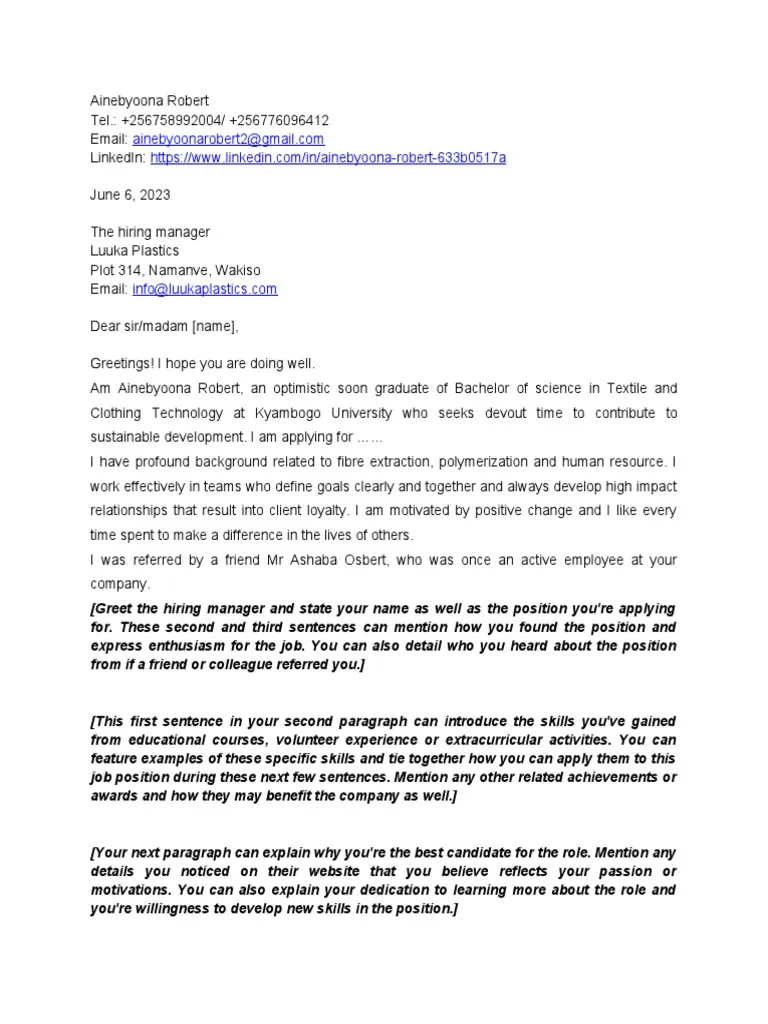
In summary, writing a compelling cover letter without prior work experience is achievable by focusing on transferable skills, highlighting education and projects, tailoring the letter to the job description, quantifying achievements whenever possible, and expressing enthusiasm for the role and company. Always research the company and the specific job requirements, and customize your cover letter to match. Use clear, concise language, and make sure your letter is free from errors. Follow the standard structure of a cover letter, including a header, personalized greeting, introduction, body paragraphs, conclusion, and professional closing. Your cover letter is your chance to make a positive first impression, so highlight your strengths, demonstrate your eagerness to learn, and showcase your potential to contribute to the company’s success. With the right approach, your cover letter will significantly improve your chances of getting your foot in the door, securing an interview, and landing the job. (cover-letter-examples.webp)
